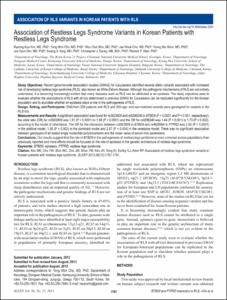Association of Restless Legs Syndrome Variants in Korean Patients with Restless Legs Syndrome
- Keimyung Author(s)
- Cho, Yong Won
- Department
- Dept. of Neurology (신경과학)
- Journal Title
- Sleep
- Issued Date
- 2013
- Volume
- 36
- Issue
- 12
- Keyword
- BTBD9; epistasis; PTPRD; restless legs syndrome
- Abstract
- Study Objectives: Recent genome-wide association studies (GWAS) for Caucasians identified several allelic variants associated with increased risk of developing restless legs syndrome (RLS), also known as Willis-Ekbom disease. Although the pathogenic mechanisms of RLS are not entirely understood, it is becoming increasingly evident that many diseases such as RLS can be attributed to an epistasis. The study objectives were to evaluate whether the associations of RLS with all loci determined in previous GWAS for Caucasians can be replicated significantly for the Korean population and to elucidate whether an epistasis plays a role in the pathogenesis of RLS.
Design, Setting, and Participants: DNA from 320 patients with RLS and 320 age- and sex-matched controls were genotyped for variants in the RLS loci.
Measurements and Results: A significant association was found for rs3923809 and rs9296249 in BTBD9 (P<0.0001 and P=0.001, respectively); the odds ratio (OR) for rs3923809 was 1.61 (P<0.0001) to 1.88 (P<0.0001) and the OR for rs9296249 was 1.44 (P=0.001) to 1.73 (P=0.002), according to the model of inheritance. The OR for the interaction between rs3923809 in BTBD9 and rs4626664 in PTPRD was 2.05 (P<0.0001) in the additive model, 1.80 (P=0.002) in the dominant model and 2.47 (P=0.004) in the recessive model. There was no significant association between genotypes of all tested single nucleotide polymorphisms and the mean value of serum iron parameters.
Conclusions: Our results suggest that the role of BTBD9 in the pathogenesis of restless legs syndrome is more universal across populations than previously reported and more efforts should be focused on the role of epistasis in the genetic architecture of restless legs syndrome.
- Keimyung Author(s)(Kor)
- 조용원
- Publisher
- School of Medicine
- Citation
- Myeong-Kyu Kim et al. (2013). Association of Restless Legs Syndrome Variants in Korean Patients with Restless Legs Syndrome. Sleep, 36(12), 1787–1791. doi: 10.5665/sleep.3200
- Type
- Article
- ISSN
- 0161-8105
- Appears in Collections:
- 1. School of Medicine (의과대학) > Dept. of Neurology (신경과학)
- 파일 목록
-
-
Download
 oak-aaa-4335.pdf
기타 데이터 / 308.65 kB / Adobe PDF
oak-aaa-4335.pdf
기타 데이터 / 308.65 kB / Adobe PDF
-
Items in Repository are protected by copyright, with all rights reserved, unless otherwise indicated.